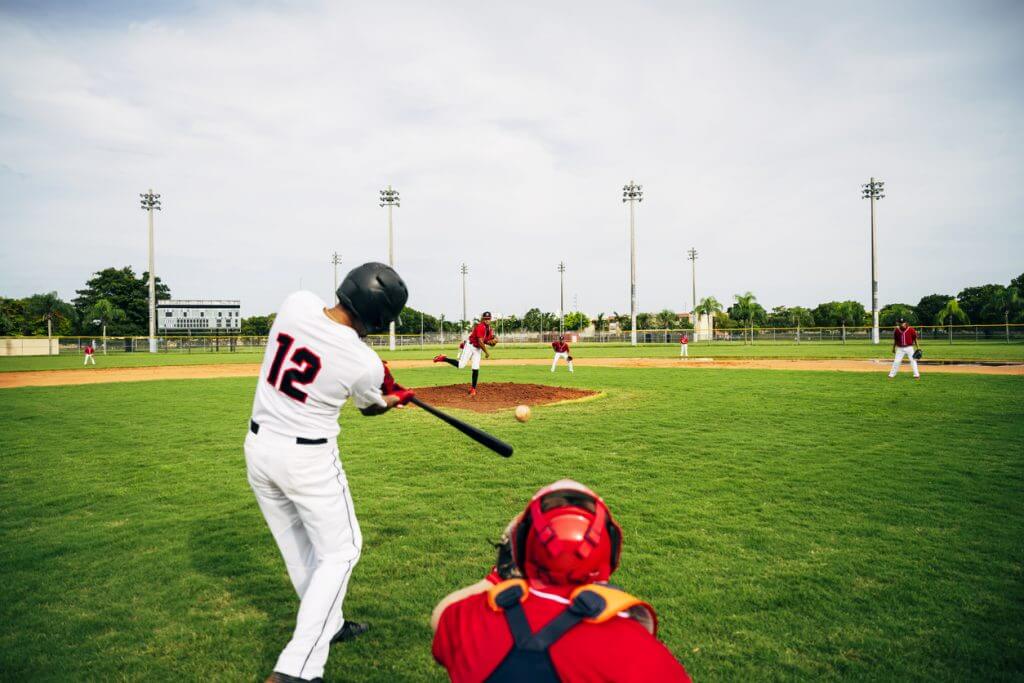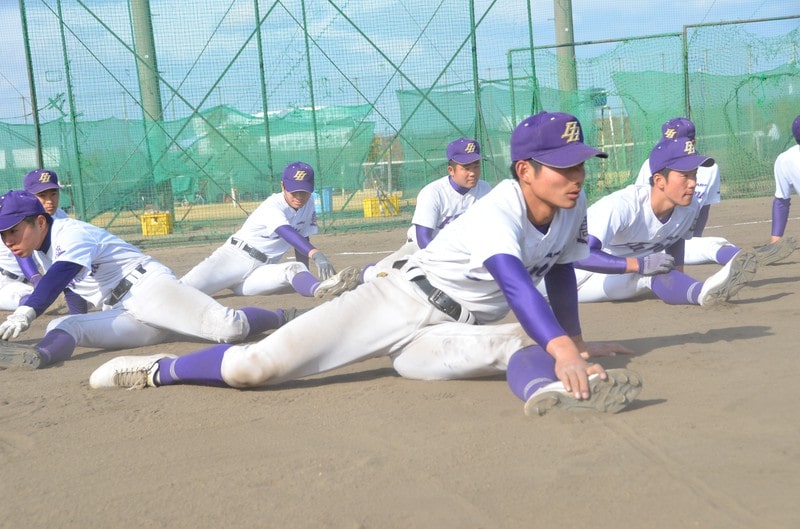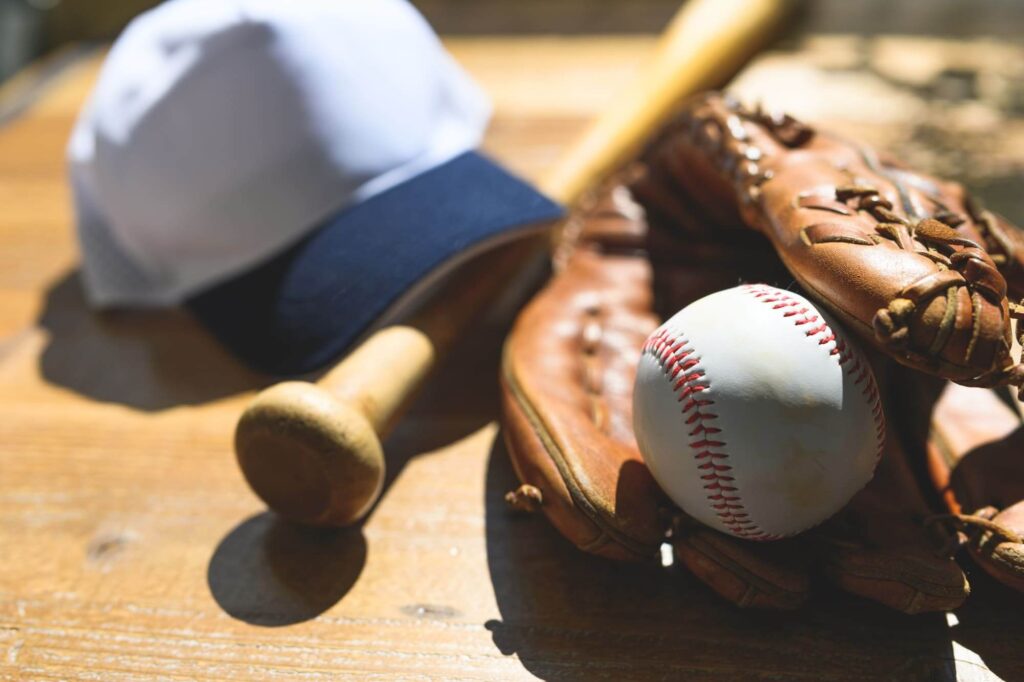
In baseball, bat selection and regulations are very important.
There are different regulations depending on the bat’s material, length, weight, and the league or level in which it is used.
Choosing the right bat can have a huge impact on a player’s performance, so understanding the latest information and regulations is essential.
In this article, we will go into detail about the basic regulations for bats, how to maintain them, and the latest bat technology.
We provide useful information for all baseball enthusiasts, from beginners to professional players.
目次
Baseball bat basics
Bats are a very important piece of equipment in baseball, and regulations regarding them have a significant impact on players’ performance and safety.
There are strict rules governing the material, length and weight of bats, and it is essential for players to understand these.
Here we will explain in detail the basic regulations regarding the material, length, and weight of bats.
About the material of the bat
Baseball bats are generally made of two materials: wood and metal.
Each material has different properties and regulations.
Wooden bats: Wooden bats are the only material used in professional baseball. They are primarily made of hard woods such as maple, white ash, and birch. Wooden bats help improve skills because they provide a natural feel to the ball and are a pure reflection of the batter’s technique. However, they are less durable and may need to be replaced more frequently.
Metal bats: Metal bats are mainly used in amateur and student baseball. Made of aluminum or alloy, they are durable and lightweight, which helps increase power. Metal bats are popular because they have high repulsion and can increase the distance the ball can travel. However, they are often banned in official professional games.
Bat length and weight standards
It is important to choose the appropriate bat length and weight according to the player’s age and level.
Each league and organization has regulations regarding bat sizes.
Bat Length: The length of the bat depends on the player’s height, weight, and hitting style. In professional baseball, the general rule is that the length should not exceed 34 inches. In youth baseball and Little League, players are expected to use bats of appropriate length depending on their age. For example, a 26-28 inch bat is recommended for players 8 years old and under.
Bat weight: The weight of the bat must also be chosen appropriately according to the player’s level and physical strength. In general, it is important that the weight of the bat is balanced with its length. The weight of a bat is expressed in ounces (oz), and for example, in professional baseball, a 34-inch bat typically weighs 31 to 33 ounces (about 880 to 940 grams).
In amateur and collegiate baseball, the weight-to-length ratio is an important factor.
The difference between a bat’s length (in inches) and its weight (in ounces) is called “drop,” and the greater this is, the lighter the bat will feel.
For example, if you have a 30 inch bat and it weighs 20 ounces, its drop is -10.
The greater the drop, the easier it is to increase your swing speed, but it also affects the power of the ball, so finding the right balance is important.
Understanding these basic regulations will help you choose the bat that is best suited for you and maximize your performance.
Using the right bat will improve your hitting accuracy and improve the quality of your play.
Always check the latest regulations and choose a bat that suits your skill level and physique.
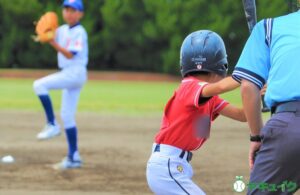
The difference between wooden and metal bats
In baseball, the choice of bat has a big impact on a player’s performance.
Wooden bats and metal bats each have different characteristics and advantages, so it is important to choose the right bat based on the player’s skill and playing style.
Here we will explain in detail the characteristics and advantages of wooden bats and metal bats, as well as the precautions to take when using them.
Features and Benefits of Wooden Bats
Wooden bats are the traditional bats used primarily in professional baseball.
Some of the features and advantages of wooden bats are:
Features:
- Materials: Mainly hard woods such as maple, white ash and birch are used.
- Feel: The ball feels natural and is a pure reflection of the batter’s technique.
advantage:
- Improved Skills: Wooden bats help improve swing mechanics and batting technique. Wooden bats are generally heavier, requiring more strength and technique from the batter, which translates into improved swing accuracy and power.
- TRADITION AND FEEL: Many players prefer the traditional feel and sound of a wooden bat, which gives the player a sense of baseball history and tradition.
- Safety: Wooden bats are considered safer than metal bats because the ball hits them at a slower speed, which reduces the risk to other players and spectators on the field.
Features and advantages of metal bats
Metal bats are primarily used in amateur and college baseball.
Aluminum and alloys are the main materials used. Metal bats have the following features and advantages:
Features:
- Materials: Aluminum, alloys and composite materials are used.
- Design: Hollow design allows for a lighter bat and increased swing speed.
advantage:
- Durability: Metal bats are much more durable than wooden bats and can withstand heavy use and strong impacts. This means you won’t have to replace your bat as often and it will last longer.
- Performance: Metal bats have a “trampoline effect” that increases ball speed and distance, allowing players to hit the ball farther.
- Wide sweet spot: Metal bats have a wide sweet spot, making it easier to get good results even with poor hitting. This increases your batting success rate.
Precautions when using
Wooden bat precautions:
- Risk of breakage: Wooden bats are prone to cracking during use, especially in cold weather. Proper storage and regular maintenance are important to prevent breakage of the bat.
Metal bat precautions:
- Check the Rules: Many professional leagues and tournaments restrict the use of metal bats. It is important to check the rules of your league or tournament and choose the appropriate bat before participating in a match.
- Vibration and hand protection: Metal bats transmit strong vibrations to the hands when hitting the ball, so it is recommended that you use batting gloves to protect your hands.
With this information, you can choose the bat that is best suited for you and maximize your performance.
By understanding the characteristics of wooden and metal bats and using them properly, you can improve your hitting technique and play safely.
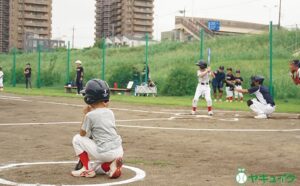
Choosing the size of a baseball bat
Choosing the right baseball bat is crucial to maximizing a player’s performance.
Bat sizes vary based on age and skill level.
Here we will explain in detail how to choose a bat for children, high school and college students, and professional players.
How to choose a bat for kids
When choosing a bat for kids, it is important to choose one that is lightweight and easy to use.
Consider the following points when choosing the right bat:
Length and Weight:
Choose the length and weight of the bat depending on your child’s height and weight. In general, the following guidelines are helpful:
- Age 5 and under: 24 inches to 26 inches
- 6-7 years: 26 inches to 28 inches
- Ages 8-9: 28 inches to 30 inches
- 10-12 years: 30 inches to 32 inches
Material:
Aluminum or alloy bats are lightweight, durable and easy to swing even for beginners. This makes it easier for kids to learn the correct swing form.
Drop:
The difference between a bat’s length (in inches) and its weight (in ounces) is called the “drop.” Kids’ bats typically have a drop of -10 to -12, which makes them lighter and easier to swing.
How to choose a bat for high school and college students
High school and college students are past their growth period and are stronger, so they need bats that provide more advanced performance.
Length and Weight:
32″ to 34″ bats are common for this age group. Bat weight is determined by the player’s strength and swing style.
BBCOR Certification:
High school and college leagues require BBCOR (Batted Ball Coefficient of Restitution) certification. This standard is designed to bring metal bats closer in performance to wood bats. BBCOR bats are standardized with a -3 drop.
Material:
Aluminum alloy and composite bats are popular at this level. These bats are durable and perform consistently.
How to choose a bat for professional players
Professional players choose bats for the best performance.
Wooden bats are mostly used.
Length and Weight:
Professional players choose the bat that best suits their swing style and build. Most players use bats that are 33″ to 34″ long. Bat weights range from 31 ounces to 34 ounces.
Material:
In professional baseball, maple, white ash, and birch are the main materials used. Maple is hard and durable, while white ash is flexible and considered to have a good balance. Birch has intermediate properties and has become increasingly popular in recent years.
Customization:
Professional players customize their bats to fit their needs, paying close attention to details such as grip thickness, barrel shape, and balance point.
Consider these points when choosing the best bat for your age and skill level.
Choosing the right bat can improve your hitting power and enhance the quality of your play.
The first step to success is to always check the latest information and choose the bat that suits you.

Examples of bat violations in baseball rules
Baseball has strict rules regarding the use of bats.
These rules are important to ensure fair competition and keep players safe.
However, sometimes bats are used that violate the rules.
Here we’ll take a closer look at what a non-compliant bat is, what to do if a violation is found, and past examples of non-compliance and their impact.
Definition of a Violating Bat
An illegal bat is a bat that does not conform to the rules of a league or tournament.
A violation has the following characteristics:
Non-standard materials:
If the material of the bat is different from that required by the rules, it is considered an illegal bat. For example, wooden bats are the standard in professional baseball, but metal or composite bats are not permitted.
Non-compliance with size and weight:
If the bat’s length or weight is outside the regulation range, it will be considered an illegal bat. In particular, amateur leagues have strict restrictions on the length and weight of bats, and bats that exceed these limits will be considered illegal.
Modified bats:
Modifying a ready-made bat to improve its performance is also a violation. For example, removing the inside of the bat or adding weight to the outside falls under this category.
What to do if a violation is found
If an illegal bat is discovered during a game, the following steps will generally be taken:
Confiscation of Bats:
If an umpire discovers a bat that is in violation, that bat will be confiscated immediately to prevent players from continuing to use the illegal bat.
Player Penalties:
Players who use illegal bats may be penalized, such as ejected from the game or suspended for a certain period of time, to ensure fairness.
Team Penalties:
In some cases, the team of the player using the illegal bat may be subject to penalties, such as forfeiture of the game and/or a fine.
Reports and Records:
If any violations are discovered, details will be reported to the league or competition organising committee and kept on official record, to prevent recurrence and promote strict adherence to the rules.
Past violation cases and their impact
Historically, there have been several notable cases of non-compliant bats, many of which had major impacts.
George Brett “Rosin Incident”:
In 1983, Kansas City Royals player George Brett had a home run voided because he was using too much rosin on his bat. This incident became known as the “Rosin Incident” and later led to changes in the rules regarding the use of rosin.
Sammy Sosa Corked Bat Incident:
In 2003, Chicago Cubs player Sammy Sosa was found to be using a corked bat during a game. Sosa was ejected from the game and was disciplined by the league. This incident is an example of how tampering with a bat can be considered a serious violation.
Examples of violations in amateur leagues:
Even in amateur leagues, the use of bats that violate regulations can be a problem. For example, if a player or team plays in a game using a bat that is out of regulation, severe sanctions may be imposed on the player or team.
These cases of non-compliance highlight the importance of following the rules and show the consequences that can result from non-compliance.
Players and coaches are urged to always check the latest rules and select the appropriate bat.
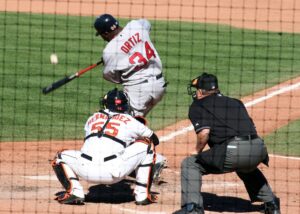
Bat maintenance and lifespan
Proper maintenance and longevity of your baseball bat is important for maintaining its performance and ensuring safety.
We will explain in detail how to properly store your bat, the importance of regular maintenance, and when to replace your bat.
How to properly store a bat
Proper storage is important to extend the life of your bat.
When storing your bat, pay attention to the following points.
Temperature and Humidity Control:
Bats are sensitive to extreme temperature changes and high humidity. Wooden bats are especially sensitive to moisture, and high humidity can cause the wood to expand and crack. It is recommended to store them in a dry, cool place. Metal bats should also be kept at room temperature, away from extreme temperatures.
Avoid direct sunlight:
Prolonged exposure to direct sunlight can cause the bat material to deteriorate. In particular, wooden bats can have their wood dry out and lose strength due to sunlight. It is important to store the bat in a cool, shady place.
Use a proper stand or case:
If you store your bat upright, it is advisable to use a dedicated bat stand. This will reduce the risk of the bat tipping over or hitting something. Also, using a bat case will protect it from dust and dirt.
The Importance of Regular Maintenance
Regular maintenance of your bat will help keep it in good condition for a long time.
Cleaning:
After using the bat, it is important to clean it. It is especially important to wipe down wooden bats with a soft cloth to remove any resin, soil or pitch stains. The same is true for metal bats, which should also be wiped down to keep the surface clean.
Oiling:
Regularly oiling your wooden bat will help prevent the wood from drying out and keep it flexible. Use a special bat oil and apply it thinly and evenly, leaving it to dry. This will reduce the risk of cracking and breaking.
Inspect:
Inspect your bat regularly for cracks, scratches, dents, etc. Inspecting your bat, especially after a game or practice, will allow you to spot any problems early and take appropriate action.
Time to replace the bat
The lifespan of a bat will vary depending on how often it is used and the storage conditions, but it is important to determine the appropriate time to replace it.
Cracks or breaks:
If your wooden bat shows signs of cracking or breaking, it should be replaced immediately. Even small cracks can put it at risk of breaking completely with continued use. Even with metal bats, if there are visible dents or cracks, consider replacing it to be on the safe side.
Decreased performance:
You should also consider replacing your bat if you feel like your bat is no longer performing as well as it used to. For example, if you notice a decrease in the distance you hit the ball or a change in the feel of your swing, your bat may be deteriorating.
Seasonal replacement:
Players, especially those at a high level of competition, may consider replacing their bats each season. This will ensure they are always performing at their best and playing safely.
By taking these points into consideration and properly maintaining and replacing your bat, you can keep it in top condition to perform at its best for a long period of time.

The latest information to help you choose a bat
Bat selection is an important factor that has a significant impact on a player’s performance.
We will explain in detail the latest technology and trends, the characteristics of popular brands, and what to consider when choosing a bat.
Latest Bat Technology and Trends
Evolution of composite materials:
In recent years, bats using composite materials have rapidly evolved. These bats are lightweight yet strong, which can improve swing speed. Composite bats also have excellent shock absorption performance and reduce hand vibration when hitting the ball.
Optimized balance:
Modern bat technology has been designed to optimize the balance of the bat. By adjusting the weight distribution of the bat, you can improve the stability of your swing and achieve more accurate hits. End-loaded bats and mid-balanced bats are particularly popular.
Enhanced trampoline effect:
The trampoline effect is the phenomenon in which the repulsive force of the bat increases when hitting the ball, causing the ball to fly farther. The latest bats are designed to maximize this effect. Metal bats, in particular, have been designed to adjust the thickness of the barrel to increase repulsive force.
Popular brands and their features
Louisville Slugger:
Louisville Slugger is known for its traditional wooden bats, but is also highly regarded for its modern composite and metal bats. Their bats are known for their durability and performance, and are popular among professional and amateur players alike.
Easton:
Easton is known for its innovative metal and composite bats. They are particularly popular with younger players because of their lightweight, easy-to-swing bats. They also offer ingenious end caps and grip designs that help players swing more comfortably.
DeMarini:
DeMarini offers many bats for power hitters, and is characterized by its end-loaded bats. The bats have high resilience and durability, and are popular with players who value distance when hitting the ball. The latest models have an evolved barrel and handle integrated design, allowing for a smoother swing.
Points to consider when choosing a bat
Choose the right bat for your height and weight:
It is important to choose the right bat for your player based on their height and weight. The length and weight of the bat should be appropriate for the player’s build. For example, a taller and heavier player will need a longer and heavier bat.
Choose the right balance for your swing style:
The balance of the bat should be chosen according to the swing style of the player. An end-loaded bat is suitable for a power hitter, whereas a mid-balanced bat is suitable for a contact hitter.
Check the standards:
It is important to check the standards of the league or tournament in which you will be using the bat and choose a bat that meets these standards. High school and college leagues often require BBCOR certification.
Swing it:
If possible, it’s important to swing the bat before you buy it to get a feel for it. Choosing a bat that matches your swing will help you maximize your performance.
By understanding the latest bat technology and trends, the characteristics of popular brands, and what to look for when choosing a bat, players can find the bat that’s best for them and perform better.
By choosing the right bat and maintaining it properly, you will be able to use it in good condition for a long time.

Baseball bats frequently asked questions
A baseball bat is an important piece of equipment that has a significant impact on a player’s performance.
We will explain in detail the expiration date of bats, the differences between children’s and adult bats, and the rules regarding the use of bats in games.
Is there an expiration date for the bat?
A bat’s shelf life will vary depending on what it’s made of, how often it’s used, and how well it’s been maintained, but there are some general guidelines:
Expiration date of wooden bats:
Wooden bats may reach the end of their life relatively quickly if they are used frequently. In particular, if they crack or break, they need to be replaced for safety reasons. Proper maintenance (for example, applying oil and storing in a dry place) can extend their lifespan, but it is usually common to prepare a new bat every season.
Metal bat expiration date:
Metal bats are more durable than wooden bats and can be used for a long time. However, if used frequently, the resilience of the bat may decrease and the distance of the ball may decrease. Even if there is no problem on the outside, internal metal fatigue and invisible cracks may occur, so regular inspection and replacement every 3 to 5 years are recommended.
What is the difference between children’s and adult bats?
There are some key differences between children’s and adult bats in terms of size, weight, and design.
Size:
Kids’ bats tend to be shorter and lighter, usually around 24-30 inches long. Adult bats, on the other hand, tend to be 30-34 inches long, depending on the player’s height and weight.
Weight:
Kids’ bats are designed to be lightweight. They generally have a larger difference (drop) between the length (in inches) and weight (in ounces) of the bat, around -10 to -12. Adult bats are heavier and typically have a -3 drop. This allows for a more powerful swing.
Design and materials:
Kids’ bats are often made from aluminum or composite materials for durability and safety, while adult bats are mostly made from wood, with professional players using high-quality woods such as maple and white ash.
Rules for using bats in games
Each league and tournament has strict rules regarding the bats that can be used in a match.
Below is a summary of the general rules:
MLB:
MLB requires players to use only wooden bats, which may not exceed 42 inches in length and have a diameter of 2.61 inches or less.
High School and College Baseball (BBCOR Standard):
In high school and college leagues, metal bats must be BBCOR (Batted Ball Coefficient of Restitution) certified. This standard is intended to limit the repulsion of metal bats and keep their performance close to that of wooden bats. The drop of the bat is standardized at -3.
Little League:
Little League has strict regulations on the size and material of bats that can be used depending on the age of the player and the league. For example, the diameter of the bat must be 2 5/8 inches (about 6.7 cm) or less, and the length must be 33 inches (about 84 cm) or less. In addition, only bats that are USABat certified can be used.
Adherence to these rules ensures a fair playing environment and the safety of players.
Always checking the latest information and choosing the appropriate bat will help players improve their performance and play safely.
